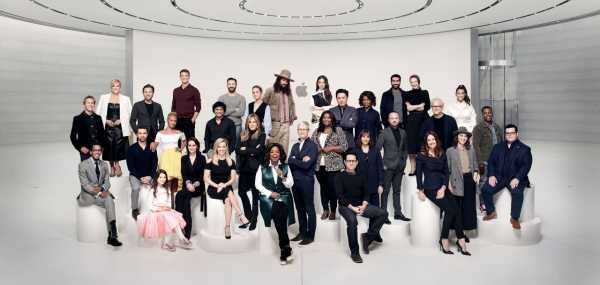
This story is part of a group of stories called

Uncovering and explaining how our digital world is changing — and changing us.
Update: On Tuesday at its annual fall event in Cupertino, California, Apple answered several big questions surrounding its new Apple TV+ video streaming service. We now know the timing and the pricing: The service will debut on November 1, and it will cost $4.99 a month. Customers who buy any iPhone, iPad, Apple TV, iPod Touch or Mac will get a one-year free trial of the service.
When Apple put on a glitzy launch event last spring to promote Apple TV+, the company left several crucial details open-ended: Like what was going to be in it, what it would cost, when it would launch, and why anyone might want to get it.
Typically, Apple’s fall product launch event focuses on iPhones, iPhones, and more iPhones. Because iPhone sales drive Apple.
But since iPhone sales are flagging, Apple has been emphasizing the sale of software, too. Which is why it is revamping its video store and video strategy, and it’s spending lots of money on its own original shows.
We know that Apple wants to make a lot of money selling other people’s videos, via subscriptions to services like HBO and Starz and taking a cut of that monthly revenue. What does it want to do with the videos it has been making for itself?
Tuesday’s news answers part of that question. And here’s everything else we know so far about the company’s plans for video:
- In 2017, Apple hired two top executives from Sony to reboot its video plans. Since then Apple has been spending heavily in Hollywood for deals with big brand names that are supposed to connote quality: Steven Spielberg, Jennifer Aniston, Reese Witherspoon, and J.J. Abrams, among others. Until recently, the company hadn’t shown more than a glimpse of any of the projects it’s funded, but that’s begun to change. Here’s Apple’s trailer for The Morning Show, one of the first programs it will debut soon:
- We don’t know exactly how much Apple has spent, but anyone who does business in Hollywood knows that Apple is willing to pay at least as much as traditional TV outfits or new competitors like Netflix and Amazon.
- A couple of years ago, Apple’s budget for this project was pegged at $1 billion; this summer, the Financial Times reported that Apple was spending $6 billion on new shows. We don’t know what time period that spending is supposed to include. But for context, Netflix is spending an estimated $15 billion on content — including shows and movies that have run in other places this year. And prior to being acquired by AT&T, HBO was spending around $2 billion a year on its own shows and movies.
- All of Apple’s budget will be spent on new TV shows and movies, but not on movies and TV shows other people have made. That means whatever service Apple does launch will look quite slim compared to services like Netflix, Hulu, and HBO, whose offerings feature a dusting of new shows and movies and lots of stuff that’s already appeared in movie theaters or on other TV networks.
- We knew that Apple intended to launch its video offering before the November 12 launch of Disney+, which is Disney’s attempt to sell video directly to consumers. Apple TV+’s planned November 1 debut accomplishes this goal. (Like everyone except Apple, Disney’s service will feature some new programming backed up by a large catalog of existing stuff that includes most of Disney’s Marvel, Pixar, and Lucasfilm, along with the complete run of The Simpsons.)
Which leads to the really big question: Does Apple think it can get people to pay for a smattering of shows, none of which they’ve heard of or seen before?
Apple has continually described Apple TV+ as a subscription service, which suggests it thinks someone might pay something, eventually. Prior to Tuesday’s pricing announcement, Bloomberg reported that Apple had been debating a $10 monthly fee: That would have been $3 more than Disney’s service and $3 less than Netflix’s basic offering.
Today’s much lower cost reflects what a stretch that would have been. While Apple has a reputation for offering similar hardware at premium prices to its competitors, that wasn’t the case when it launched its music service, which offered the same thing, more or less, as Spotify, at the same price. Charging anything close to the competition when you don’t have much to offer wouldn’t have made any sense.
Offering a free one-year trial period for customers who buy Apple hardware also makes it easier for the company to attract subscribers to its TV service. It’s possible that in the future, Apple may vary the price, depending on if you’re using Apple’s hardware — Apple wants to encourage you to keep buying iPhones, after all — or if you are buying other services from Apple, like its music service.
It is worth noting that in a change from the past, Apple has struck deals to get its video service widely distributed on other people’s hardware, including Samsung TVs and Roku streaming boxes. Maybe people who watch the service on those platforms and don’t have any other relationship to Apple will pay full boat.
But, again, none of this matters at all if Apple can’t create stuff people want to watch. And we are definitely going to start getting an answer to that question very soon.
Sourse: vox.com




